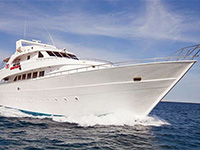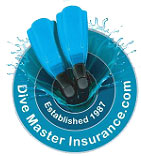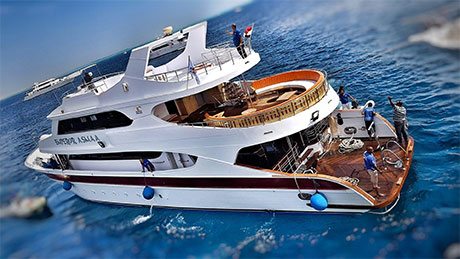Reviews: "Love the newsletters! Keep them coming" Janice Fleming...MORE REVIEWS

Diving St John's and Fury Shoals
26 June 2024
St John's has fabulous diving. Stunning coral plus large shoals of fish, turtles, dolphins and sharks. It's a collection of small reefs in the far south of Egypt covering around 290 km2. Fury Shoals, also with great diving, is 100 km north.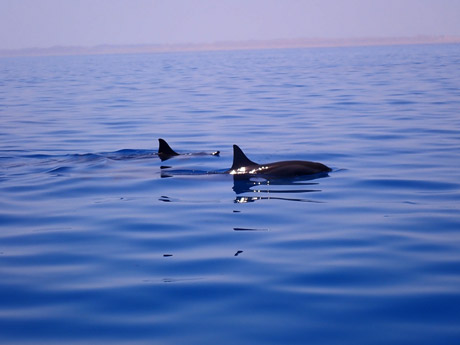
Dolphins at Fury Shoals
You can dive St John's and Fury Shoals throughout the year by taking a liveaboard departing, for example, from Port Ghalib which is 3 km from the Marsa Alam airport. The liveaboards will generally arrange an airport pick up from either Marsa Alam or Hurghada. You will need 30 or 40 dives to experience St John's. Take your log book, qualification cards and insurance documents with you. Any extras you buy on board - beer, 15l tanks, etc - you can pay for in US dollars, Euros, British or Egyptian pounds.
Find a St John's liveaboard deal
Forty-eight km offshore, St John's is 115 km from Hamata in the south of Egypt.
When is the Best Time to Dive St John's and Fury Shoal?
You can dive here year round but some of the best diving is in the summer months. This is the most likely time to see hammerhead sharks at St Johns. Spinner and bottlenose dolphins are frequent visitors.
Average Sea Temperatures in St Johns (°C) | ||||||||||||
| Jan | Feb | Mar | Apr | May | Jun | Jul | Aug | Sep | Oct | Nov | Dec | |
| 23 | 22 | 22 | 23 | 25 | 26 | 28 | 29 | 28 | 27 | 26 | 24 | |
St John's Dive Sites • Fury Shoal Dive Sites • Liveaboards • Red Sea Life • Diving Insurance • Further Reading • Your Comments & Reviews • Other Parts of the Red Sea: Sharm, Sudan, etc
The Dive Sites of St John's & Fury Shoals
You will not be disappointed in the dive sites of St John's and Fury Shoals. Great vis, beautiful reefs, caves and always the chance of seeing sharks and turtles.
Paradise Reef • Habili Ali • Gota Kebir • Habili Gaffar • Gota Soraya • St John's Caves • Dolphin Reef • Malahi • Shaab Claudia • Shaab Maksour • Abu Galawa Soraya • Daedalus Reef • Other Parts of the Red Sea: Sharm, Sudan, etc
Paradise Reef
A forest of coral pinnacles to swim around in the south-east corner of the reef. Turn the corner with the reef on your right and you find a wall. Here there are swim-throughs and caverns - very pretty. Look for delicate sea fans in the overhangs. Abounding with mountains of porites hard coral in pale olive and blue. A dive for everyone.
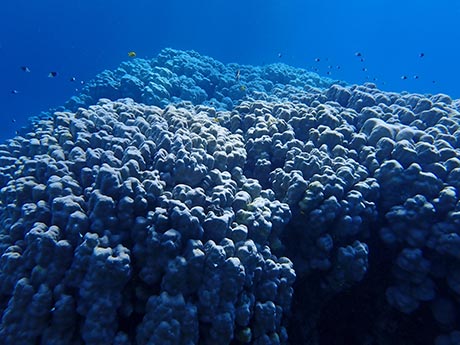
Porites coral at Paradise Reef. Photo credit: JS
Habili Ali
A small oval reef. You'll probably be dropped at one end to swim round one side of the reef back to the boat. It plateaus between 3 and 7 m from the surface and has fairly steep sided walls.
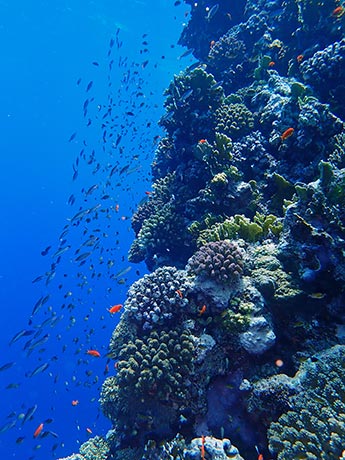
Wall of coral, Habili Ali. Photo credit: JS
Gota Kebir
The dive comprises reef walls and plateaus. Lovely soft corals, shoals of fish and often a Hawksbill turtle. Kebir means big and this is one of the largets reefs in the St John's area at 250m long and 120m wide..
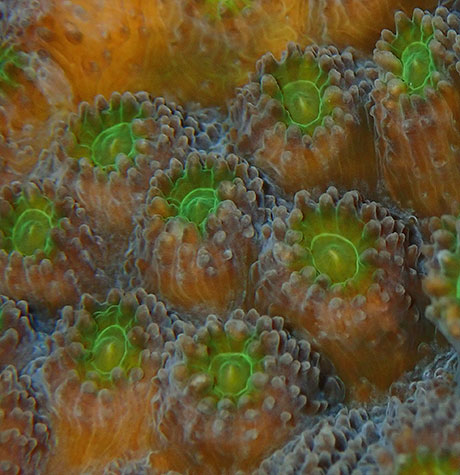
Coral close-up at Gota Kebir. Photo credit: JS
Habili Gaffar
Also spelled Habilie Jafar. A beautiful pinnacle dive. The pinnacle reaches to within 5 or 6 metres from the surface and drops to over 60 m. At 40 m the drop-off steepens. Look down here and you might see white tip sharks.
You can circle around the pinnacle gradually rising to finish the dive at the reef top. An octopus lives on the top of the reef with pixie hawkfish sitting nearby waiting for crumbs from the octopus's table. Barracuda also lurk nearby.
The current is most often from the North
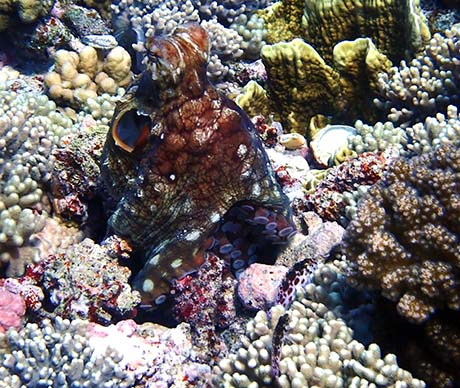
Octopus and Pixie Hawkfish on Habili Gaffar, St Johns. Photo credit: JS
Gota Soraya
The name means small and with good air consumption this is another one you can swim completely around. But it is a lot of finning with any sort of current. A better plan is to go in at one side of this circular reef - the north if this is the direction from which the current is coming - and drift back to the south.
Look for a fan coral garden running between 20 and 6 m on the east side. The reef almost touches the surface and at its shallowest part in the south has crevices cutting in.
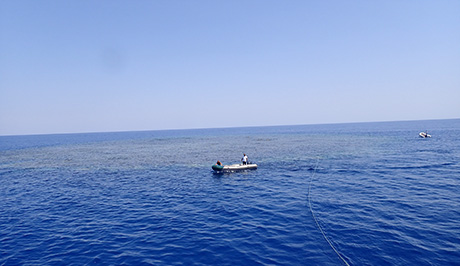
Gota Soraya reef, St Johns. Photo credit: JS
St John's Caves
Dive in and out of swim-throughs and caves. Many juvenile fish with the bonus of a resident Napoleon Wrasse which likes to investigate divers. Octopus in holes. A good spot for night diving.
Dolphin Reef - Shaab Sataya
This is a really lovely dive. Loads of fish: blackfin dart fish, juvenile golden trevally trying to be a pilot fish, goat fish, parrotfish galore right up to tuna and eagle ray. And of course - lots of dophins on the surface. At the south eastern tip of Fury shoal. Best dived from a liveaboard but can be done by boat from Marsa Alam. This is a horseshoe-shaped reef enclosing several pinacles in a coral garden. The outer edge of the horseshoe is deep and the inner shallow.

The dolphins of Dolphin Reef. Photo credit: JS
Malahi
Malahi means playground, and it is like a playground for divers. Everywhere there are swim-throughs and coral pillars and outcrops to swim in and out of. This is made from a collapsed reef. Maximum depth 14 m. The north side has some especially nice formations of hard corals. Home to a grumpy turtle which as been known to bite people. Plenty of squirrelfish - Crown and Bloodspot (Neoniphon sammara)
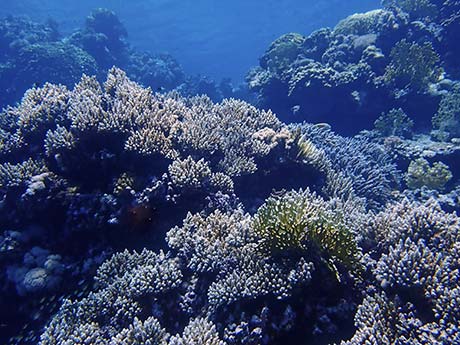
Coral at Malahi. Photo credit: JS
Shaab Claudia
Another great dive. Cathedrals of corals in the west. Massive dome corals - Porites nodifera. Large giant morays. Admire the magnificent corals in the south then turn right into swim-throughs and caves. Interesting tall yellow sponges, nudibranchs and some beautiful Brain coral, Platygyra daedalea. Another good place for a night dive where the basket stars are out and moving around plus tiny shrimp, coral crabs, hermit crabs and other invertebrates.
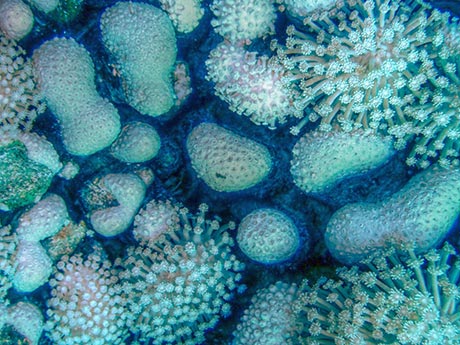
Shaab Maksour (Broken Reef)
Two plateaus at the north and south ends. Pinnacles on the south plateau are covered in soft corals. The south plateau starts at 18 m and slopes down to 35 m. Look out for white tip reef sharks and grey reef sharks here. (Like whitetip reef sharks, grey reef sharks have a white end to their dorsal fin, but they have a black edge to their tails.) You might also see a Napoleon (Maori) wrasse, hawksbill turtle and nudibranchs. Current is often north to south.

Abu Galawa Soraya
The name of this dive translates to Father of the Small Pool. It is very pretty inside the "pool". Look out for the Red Sea Walkman near the wreck of a small yacht which sank 20 years ago. Chestnut blennies sit on top of the coral whist Seba's spider conch moves slowly across the sand leaving a distinctive trail.
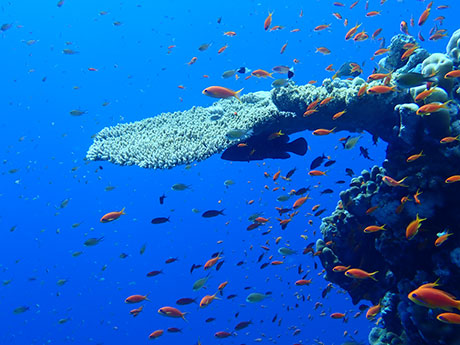
"An easy dive that starts with a coral canyon into the middle of the reef where there is a spectacular coral garden still relatively unspoilt. You exit the garden onto the opposite side of the reef where there is a sandy bottom with a number of coral pinnacles full of life, then to cap it all you arrive at the wreck of a sailing yacht! Carry on following the reef past the wreck and you arrive back at the start. A very picturesque and easy dive, max depth is 20ish mt around the base of the pinnacles the rest is shallower 15-18 mt"
Andrew Reay-Robinson, 2022
Liveaboards often visit Daedalus Reef as part of a St Johns or Fury Shoal trip. It is far out into the Red Sea, 80 km east of Marsa Alam. This remote reef is 400 m long and 100 m wide. A manned lighthouse sits atop it. It used to be that you couldn't go in the lighthouse but now they welcome divers and even sell us T-shirts.
Daedalus is a fantastic dive spot. Hammerhead sharks cruise at the north end - some of these beautiful beasts might even come to have a look at you. You can also see manta rays, tuna, titan trigger fish, white tip reef sharks, barracuda, napoleon wrasse, and, if you look away from the fish, nudibranchs. The visibility is perfect.
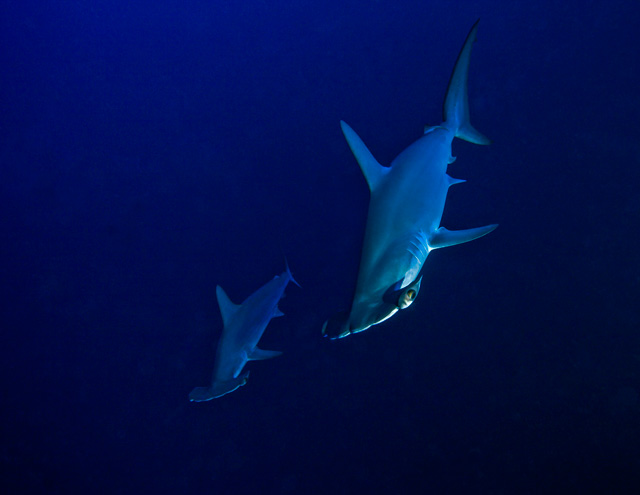
Liveaboards to St Johns and Fury Shoal: Egypt's Deep South
The boat provides facilities for tech diving. This liveaboard has 11 cabins that can accommodate 22 divers. Free cancellation up to 30 days prior the departure day
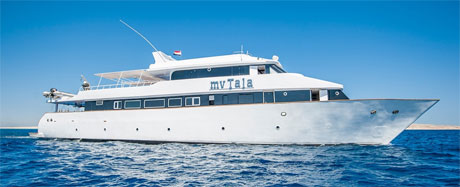
Luxury liveaboard which was awarded the 2013 “Best Liveaboard” by Sport Diver magazine. If you book now you can cancel for free for up to 60 days. 30% off all 2020 departures; 3+1 across all destinations. 20% off all 2021 onwards.
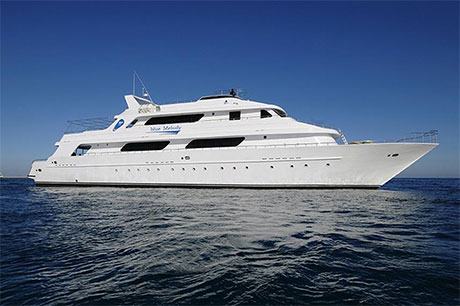
Further Reading to the Red Sea
- Indian Ocean & Red Sea Fish Guide
- by Helmut Debelius, KINDLE / ANDROID, 2013.
The fish sections of Helmut Debelius' Indian Ocean & Red Sea Reef Guides are now available as an app for Android / Kindle.Covers 650 species with more than 900 photos
The original hardback goatfish work together as a team to catch food. Debelius, though, had described this behaviour in the 2003 edition of his book (and possibly earlier - 2003 is the date of my copy). Buy
Books
For those who prefer hard copies, we recommend.
- Coral Reef Guide Red Sea
- by Ewald Lieske and Robert Myers, Collins, 384 Pages, Paperback (2012)
Coral Reef Guide Red Sea covers all common species of underwater life of the Red Sea and the Gulf of Aden, you are likely to see while diving or snorkelling. Each species is illustrated with a full-colour photograph and the text gives details of range and characteristic behaviour. A map of good dive sites appears on the inside front cover. Includes jellyfish, corals, nudibranchs, starfish, sea urchins, fishes and turtles. An excellent sea life guide which I always take to the Red Sea
Your Comments
Please add your comments. Do you want to recommend a dive operator? Let us know.
Rest of the Red Sea
Or jump to Europe, Africa, Pacific, Asia, Americas, Caribbean, Elsewhere...
